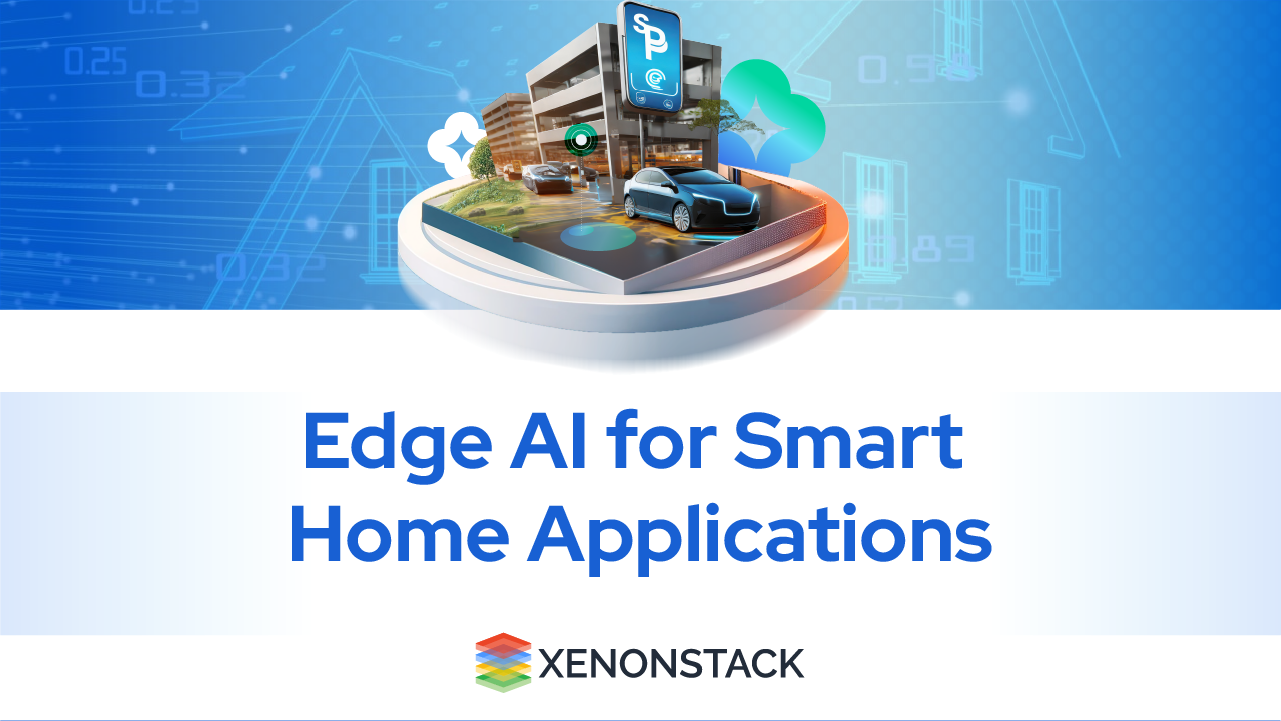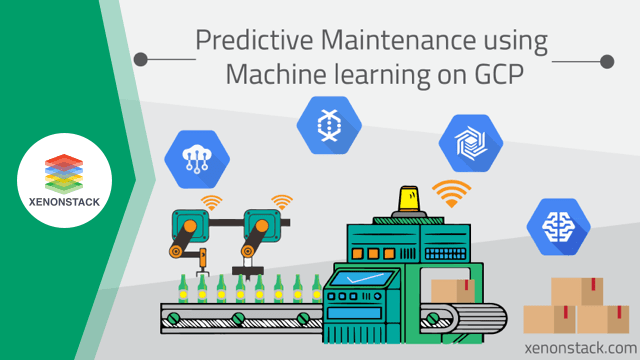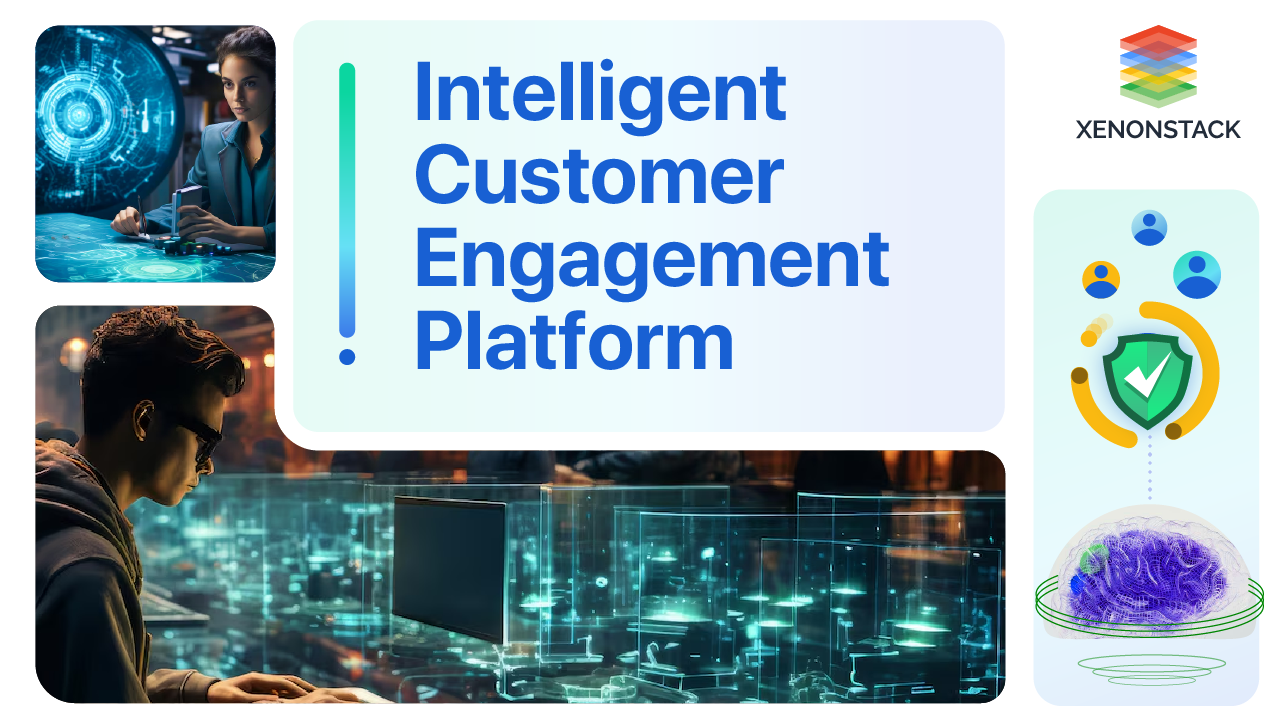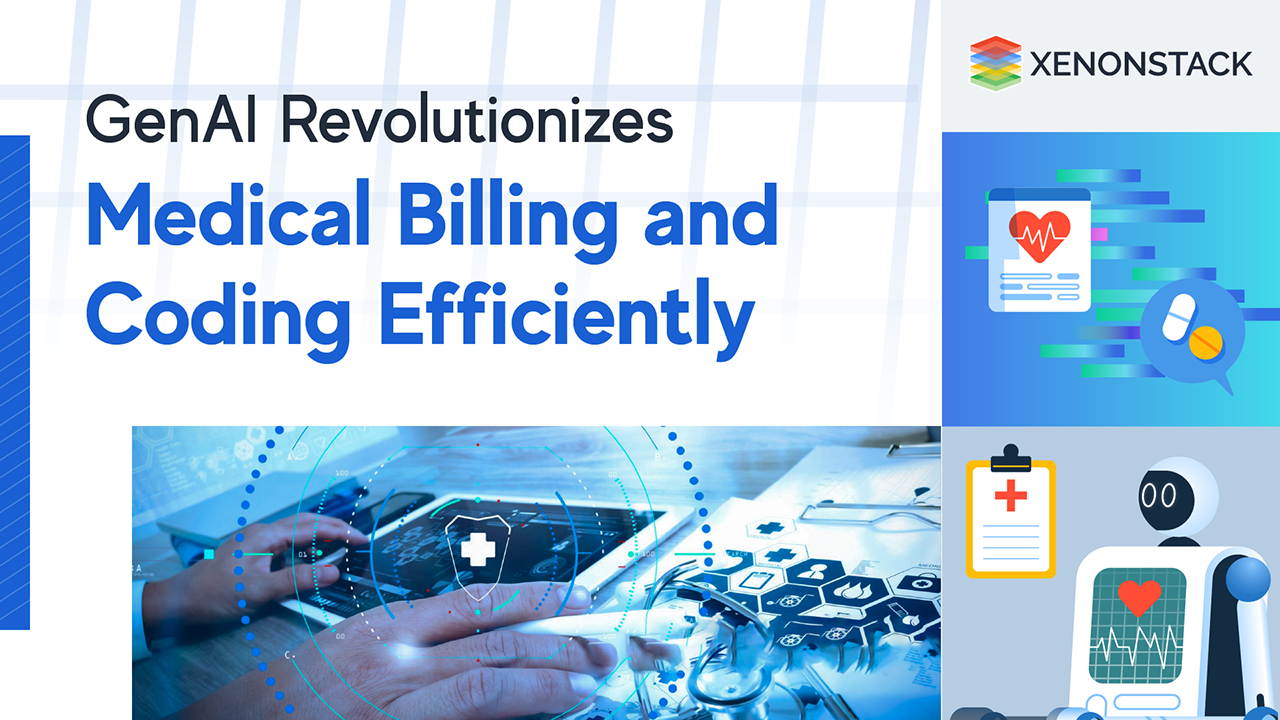
Healthcare Documentation with Generative AI
Healthcare stands at a pivotal moment. Patients increasingly expect modern, digital experiences, yet many systems still rely on outdated paper and cumbersome software. This outdated approach leads to inefficiencies, errors, and frustrations for patients and providers alike.
The consequences? Burnout among healthcare professionals and delays in patient care. But there's a promising shift underway: the healthcare industry is embracing automation, focusing on Generative AI (Artificial Intelligence) to revolutionize medical documentation, enhance accuracy, and empower healthcare teams.
This blog delves into the development of a digital solution using Generative AI to automate medical documentation processes.
The aim? To streamline documentation tasks, enabling healthcare professionals to prioritize what truly matters: delivering optimized patient care at every stage.
Imagine a future where medical documentation is automated, freeing up doctors and healthcare workers from administrative burdens. No more grappling with paperwork—just more time dedicated to patient interactions and critical decision-making. This Gen AI-driven efficiency promises significant benefits.
Why does this matter? Generative AI reduces errors stemming from fatigue or oversight, ensuring healthcare providers have access to reliable, current information. This enhances collaboration and promotes seamless care delivery, ultimately leading to fewer medical errors and improved patient outcomes.
The Power of Generative AI in Healthcare: A New Era of Documentation
In the healthcare industry, Generative AI is revolutionizing medical documentation creation. With Generative AI Models, medical professionals can easily generate accurate and comprehensive documentation, reducing the time and effort spent on manual writing. The Generative AI Architecture is designed to learn from large datasets of medical records, allowing it to generate documentation that meets the highest standards of accuracy and compliance.
For instance, in a Pilot Generative AI project, Generative AI was used to create healthcare documentation for patients with chronic conditions, resulting in a significant reduction in errors and improved patient outcomes. To ensure the Responsible Use of Generative AI, healthcare organizations must implement strict guidelines and protocols for the use of Generative AI in healthcare documentation. Furthermore, the integration of LLMs and Knowledge Graphs can enhance the accuracy and relevance of generated documentation, making it an essential tool for healthcare professionals. As the industry continues to evolve, Generative AI will play a crucial role in Intelligent Automation, enabling healthcare organizations to streamline their operations and focus on providing high-quality patient care
Medical documentation, encompassing crucial tasks like billing and coding, faces significant challenges that hinder efficiency and accuracy. Here's a snapshot of the current struggles, illustrating where Generative AI (Gen AI) can drive substantial improvements:
-
Inbox Avalanche: Healthcare professionals are inundated with a constant stream of emails, messages, and calls. Sorting through these communications to prioritize urgent issues consumes valuable time and resources.
-
Data Inconsistency: Patient demographics and insurance information, typically entered at the front desk, often contain inconsistencies. Rectifying these errors demands meticulous tracking and verification to maintain data accuracy.
-
Eligibility Enigma: Verifying patient eligibility with insurance providers remains a cumbersome process, frequently involving prolonged phone calls and wait times, which can delay billing processes.
-
Coding Challenges: Transferring charges from various systems into practice management software involves manual data entry, prone to errors that can disrupt billing cycles and reimbursement workflows.
These obstacles underscore the urgent need for innovative solutions like Generative AI to streamline medical documentation processes, particularly in coding and billing. By automating repetitive tasks, ensuring data consistency, and accelerating eligibility verifications, Gen AI holds the potential to enhance efficiency, minimize errors, and optimize healthcare provider workflows.
Medical Documentation Challenges: Coding and Billing

Figure: Challenges in Manual Medical Documentation
The healthcare industry faces numerous hurdles in providing optimal care. Here are major challenges where Generative AI (GenAI) steps in to offer significant improvements:
-
Manual Data Entry: Transferring data between different systems, like EHRs and billing software, is often a manual process prone to errors. Generative AI can automate this data transfer, eliminating errors and saving time.
-
Eligibility Errors: Verifying patient insurance eligibility can be cumbersome, involving phone calls and long wait times. Generative AI-powered billing systems can connect directly with insurance companies to automate eligibility checks, improving efficiency and reducing errors.
-
Coding Mistakes: Medical coding is a complex task that requires specialized knowledge. Manually assigning the correct codes can be time-consuming and error-prone. Generative AI can analyze medical records and suggest appropriate codes, reducing coding errors and ensuring accurate billing.
-
Claim Denials: Many claims are denied by insurance companies due to errors or missing information. Generative AI can analyze denied claims and identify patterns in the errors. This information can then be used to improve the accuracy of future claims submissions, reducing denials, and improving revenue collection.
-
Repetitive Tasks: Medical billers dedicate a substantial portion of their time to repetitive tasks like issuing invoices and pursuing unpaid claims. Generative AI can automate these tasks, freeing up billers to focus on more complex issues.
Developing Generative AI Solutions for Healthcare
The realm of medical billing and coding is notorious for its complexities and inefficiencies. However, Generative AI (GenAI) presents a promising avenue for automation and improvement. Here’s a structured roadmap to guide the development of a GenAI solution tailored specifically for automating medical billing and coding processes:
Elements of GenAI Solution in Healthcare
The healthcare industry stands on the brink of a transformative revolution driven by Generative AI (GenAI). To harness this potential and enhance patient care, consider these foundational principles:

Figure: Elements of Healthcare Platform
Proximity
Patient data privacy is paramount. Opt for a GenAI solution where data and AI applications are hosted in close proximity, such as regional cloud storage. This setup minimizes data travel distances, reduces latency, and ensures faster, secure processing of patient information critical for real-time applications and personalized care experiences.
Platform
GenAI encompasses more than just models; a robust platform integrates various essential elements:
-
Pre-trained GenAI models: These serve as the foundation for tasks like natural language processing and code analysis in medical billing.
-
Data Management Tools: Secure and scalable tools are vital for storing, organizing, and cleansing vast amounts of healthcare data to train and optimize GenAI models.
-
Model Development and Deployment Tools: Streamlined workflows facilitate the building, training, and deployment of GenAI models within the platform, empowering healthcare providers to apply AI effectively to address specific challenges.
-
Security and Compliance Features: Adherence to stringent healthcare data privacy regulations ensures patient trust and compliance, safeguarding sensitive medical information.
Productivity
GenAI is designed to assist, not replace, healthcare professionals. Develop GenAI solutions with accessible, user-friendly development tools. This accessibility allows healthcare professionals, including those with limited coding expertise, to leverage pre-built tools and functionalities to customize GenAI solutions tailored to their unique needs. By prioritizing user-friendly interfaces and pre-built components, developers can streamline operational tasks, freeing up time and resources for innovation and addressing critical healthcare challenges.
This 3 P approach—Platform, Platform, and Productivity—empowers healthcare organizations to build and has been used to develop a GenAI solution. The solution can unlock valuable insights, streamline workflows, and improve patient care delivery. Let us understand the approach and the flow of the solution as well.
Approach to Implementing Generative AI
Following is the structured approach, focusing on Platform, Proximity, and Productivity (the 3 P approach), empowers healthcare organizations to develop and deploy GenAI solutions that unlock valuable insights, streamline workflows, and enhance patient care delivery. By automating medical billing and coding processes, GenAI not only improves accuracy and efficiency but also supports healthcare providers in delivering optimal patient outcomes and operational excellence.
Defining Objectives and Stakeholder Alignment
-
Objective Definition: The first step is to define objectives with healthcare stakeholders, focusing on enhancing billing accuracy, reducing claim denials, and optimizing coding efficiency.
-
Detailed Requirements: Gather comprehensive requirements to integrate seamlessly into existing workflows and comply with data privacy regulations.
Secure Data Acquisition and Preparation
-
Secure Data Access: Establish secure access to healthcare data (e.g., patient demographics, medical records) adhering to HIPAA regulations (or any other regulation applicable according to law of land).
-
Data Preprocessing: Standardize data, handle missing values, and anonymize sensitive information to prepare for AI model training.
Integration of Advanced Gen AI Models
-
Advanced Model Integration: Integrate state-of-the-art Generative AI models (e.g., BERT, LSTM) enhanced by large language models (LLMs) like BART and GPT-3 for superior NLP (Natural Language Processing) capabilities. For implementation, we have Llama 3 and GPT—4 Combination.
-
Training and Optimization: Use machine learning algorithms to train models on large-scale healthcare datasets and refine accuracy in medical coding tasks.
Designing Scalable System Architecture
-
Scalable Architecture: Design robust system architecture integrating powerful LLMs (e.g., Jurassic-1 Jumbo) with intuitive user interfaces for seamless healthcare integration. The current solution is available with both architecture options: on-premises and Off-premises (with cloud services like AWS (Amazon Web Services), Azure, and Service Now).
-
User-Centric Design: Develop user interfaces tailored for healthcare professionals, ensuring ease of use and effective workflow integration.
Rigorous Testing and Validation
-
Comprehensive Testing: Conduct rigorous testing to validate system performance with real-world healthcare data, ensuring high accuracy and compliance.
-
Optimization: Benchmark system outputs against manual coding standards, continuously optimizing AI models and algorithms for enhanced performance.
Seamless Deployment and Integration
-
Pilot Deployments: Deploy pilots within healthcare facilities to validate reliability and integration capabilities, gathering user feedback.
-
Full-Scale Rollout: Integrate automated systems into broader healthcare environments, supporting scalable data handling and comprehensive user training.
Continuous Monitoring and Maintenance
-
Real-Time Monitoring: Implement robust monitoring tools to track system performance (e.g., processing times, accuracy rates) for proactive issue resolution.
-
Security and Compliance: Maintain stringent security measures and healthcare regulations compliance to protect patient data integrity.
Evaluation and Continuous Improvement
-
Impact Assessment: Evaluate system improvements in billing accuracy, administrative efficiency, and revenue cycle management.
-
Iterative Enhancements: Gather stakeholder feedback to enhance AI capabilities and system functionalities for ongoing advancements.
Additional Considerations
-
Explainability: Explainability is an important part of the solution when it is subjected to healthcare. LIME (Local Interpretable Model-Agnostic Explanations) has been used to make AI decisions more transparent for healthcare professionals.
-
Scalability: Design the solution to handle increasing data volumes and user base as adoption grows within the healthcare system.
Flow and Integration of Generative AI Solutions
Let us check the solution's flow on an elevated level. By utilizing these expanded steps and understanding the potential use cases, healthcare providers can gain valuable insights into how a GenAI-powered medical billing solution can streamline their workflows, improve accuracy, and optimize revenue collection.
Patient Encounter
-
Electronic Health Record (EHR) Entry: Healthcare professionals input clinical data, including diagnoses, procedures, and medications, into the EHR system.
Data Extraction & Pre-Processing
-
Automated Data Extraction: Generative AI extracts pertinent information from the EHR such as clinical notes, demographics, and diagnoses.
-
Data Pre-Processing: Clean inconsistencies, standardize formats, and anonymize sensitive data to ensure compliance with privacy regulations.
Automated Coding & Confidence Scoring
-
AI-Powered Coding: Algorithms analyze extracted data to assign accurate billing codes based on predefined rules and machine learning models.
-
Confidence Scoring: Each code is accompanied by a confidence score, indicating the model’s certainty in its coding decision.
Review & Adjustment
-
Human Oversight: A coder reviews assigned codes and confidence scores.
-
Decision Validation: High-confidence codes are auto-accepted; for others, coders adjust or confirm codes needing human expertise.
Claim Generation
-
Automated Claim Formulation: The system generates a comprehensive claim form detailing diagnoses, procedures, and charges based on finalized codes.
Pre-Submission Analysis & Optimization
-
AI-Driven Analysis: Tools examine the claim for issues such as missing data, errors, or duplicates.
-
Optimization Recommendations: Suggest optimizations like procedure bundling or upcoding opportunities for appropriate reimbursement.
Claim Submission & Real-Time Monitoring
-
Electronic Submission: Optimized claims are electronically submitted to insurance providers.
-
Real-Time Status Updates: AI monitors claim progress in real-time, providing updates on statuses (received, pending review, approved, denied).
Decision & Action
-
Approved Claims: Proceed to reimbursement.
-
Denied Claims: AI identifies reasons (e.g., documentation gaps, coding errors) and proposes corrective actions.
-
Resolution Steps: Coders address issues and resubmit claims as necessary to ensure successful processing.
Example

Figure: Streamlining Medical Documentation with GenAI
Brief descriptions of the example:
Imagine this: A patient visits a doctor for a checkup. The doctor records details electronically in the patient's health record. Behind the scenes, GenAI springs into action:
-
Data Extraction: It automatically extracts relevant information from the record, like diagnoses and procedures.
-
Automated Coding: AI analyzes the data and suggests appropriate billing codes for the services rendered.
-
Human Review & Adjustment: A coder verifies the codes with high confidence scores and adjusts those requiring expertise.
-
Claim Generation: A complete claim is generated with accurate codes and charges.
-
Pre-Submission Analysis: AI scans for potential errors or missing information, ensuring a smooth submission.
-
Real-Time Monitoring: The system tracks the claim's status and provides updates.
-
Faster Reimbursement: Upon approval, reimbursement is received efficiently.
Generative AI Use Cases in Healthcare
The following use cases demonstrate how a Generative AI-powered solution can revolutionize medical coding and billing processes across diverse healthcare settings, enhancing efficiency, accuracy, and financial performance.
Large Hospital Optimization
-
Scenario: A large hospital managing high patient volumes and complex billing processes.
-
Use Case: Implementing a Generative AI solution for automated coding and billing to streamline operations and accelerate claim processing.
-
Benefits: Enhanced operational efficiency, reduced errors in coding and billing, faster revenue cycle, and improved resource utilization.
Specialized Clinic Efficiency
-
Scenario: A specialized clinic focusing on specific medical disciplines like oncology or neurology.
-
Use Case: Utilizing Generative AI for accurate coding of specialized procedures unique to the clinic's services.
-
Benefits: Improved accuracy in coding complex procedures, faster claim submissions, minimized compliance risks, and optimized reimbursement for specialized treatments.
Telehealth Service Provider
-
Scenario: A telemedicine provider offering remote consultations and digital health services.
-
Use Case: Integrating Generative AI for automated coding and billing of virtual visits and remote patient monitoring.
-
Benefits: Streamlined billing processes for telehealth services, reduced administrative burden, increased billing accuracy, and faster revenue realization.
Healthcare Network Consolidation
-
Scenario: Merging multiple healthcare facilities into a unified network.
-
Use Case: Deploying Generative AI to standardize coding practices across merged entities and integrate disparate billing systems.
-
Benefits: Unified coding standards across the network, streamlined consolidation processes, reduced operational costs, and enhanced financial reporting capabilities.
Solo Practitioner Efficiency
-
Scenario: A solo medical practitioner managing a small practice independently.
-
Use Case: Adopting a Generative AI solution for automated coding and billing to efficiently manage administrative tasks without dedicated billing staff.
-
Benefits: Time savings reduce overhead costs, improved billing accuracy, better cash flow management, and increased focus on patient care.
Benefits of Generative AI in Medical Billing and Coding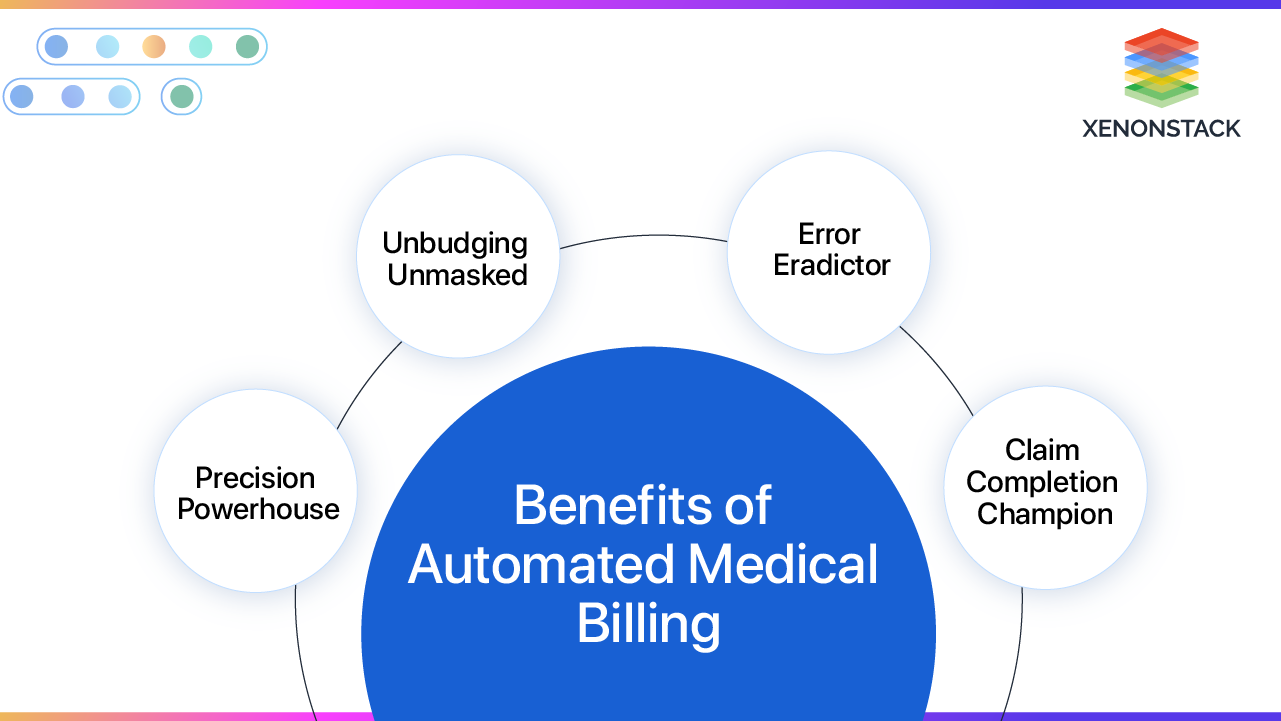
Figure: Benefits of Implementing Gen AI
GenAI Large Language Models (LLMs) are revolutionizing medical billing by offering a powerful set of advantages:
-
Precision Powerhouse: LLMs excel at interpreting complex medical jargon and nuances within documentation. This translates to accurate code assignment, minimizing the risk of under- or over-coding claims and ensuring proper reimbursement.
-
Error Eradicator: By understanding the context of medical records, LLMs can detect and rectify coding errors. They act as watchful guardians, flagging inconsistencies and discrepancies for human review and preventing fraudulent practices.
-
Unbundling Unmasked: GenAI models are adept at identifying patterns and relationships within medical data. This allows them to detect instances of unbundling, where separate codes are billed for procedures typically performed together. This helps prevent upcoding and ensures accurate billing practices.
-
Claim Completion Champion: Incomplete or unclear documentation can lead to claim denials. LLMs come to the rescue by leveraging natural language processing. They can analyze ambiguities and suggest missing details or clarifications needed for accurate billing, minimizing claim rejections.
-
Productivity Booster: Repetitive tasks are outdated with GenAI. LLMs automate routine coding functions, freeing up valuable time for medical billers. They can generate code suggestions based on context, allowing human experts to focus on complex cases and improve overall billing team efficiency.
In essence, GenAI empowers medical billing with a new level of accuracy, efficiency, and vigilance, ensuring proper reimbursements and a smoother financial flow for healthcare providers.
Insights from Generative AI in Healthcare
Imagine a medical billing system that not only automates tasks but also unlocks valuable insights for improved efficiency and financial performance. Here is how a GenAI solution can transform your understanding of medical billing:
-
Coding Clarity: GenAI can analyze vast amounts of medical records and historical coding data. This allows for identifying patterns and potential inconsistencies in coding practices. Insights gained can be used to improve coding accuracy and ensure compliance with regulations.
-
Denial Detection: GenAI can analyze denied claims and identify trends in the types of errors or missing information that led to denials. This proactive approach allows healthcare providers to address these issues and prevent future denials, maximizing reimbursements.
-
Revenue Optimization: GenAI can analyze historical billing data and identify areas where under-coding might be occurring. These insights can help capture the full value of services rendered and optimize revenue collection.
-
Audit Preparation: GenAI can simplify audit preparation by maintaining a clean and accurate coding record. The ability to readily access data and identify potential issues beforehand reduces stress and streamlines the audit process.
-
Predictive Analytics: GenAI can analyze trends in patient demographics, procedures performed, and insurance coverage. These insights can be used to predict future billing patterns and resource requirements, allowing for better financial planning and proactive cost management.
-
Fraud Prevention: Gen AI's ability to detect anomalies in coding patterns can help identify potential instances of fraudulent billing. This proactive approach safeguards revenue and protects the integrity of the healthcare system.
Beyond automation, a GenAI-powered solution empowers you with valuable insights, enabling data-driven decision-making for a more efficient and financially robust healthcare practice.
Conclusion
In conclusion, the advent of Generative AI in medical coding and billing marks a significant leap forward in healthcare administration. This advanced technology streamlines processes by automating coding tasks, optimizing billing accuracy, and expediting claim submissions across diverse healthcare environments. From large hospitals managing complex workflows to solo practitioners seeking operational efficiency, Generative AI enhances productivity, reduces errors, and improves financial outcomes. By leveraging Generative AI solutions, healthcare providers can not only achieve greater efficiency in administrative tasks but also allocate more time and resources to delivering superior patient care. As healthcare continues to embrace innovation, Generative AI stands as a transformative force in shaping a more streamlined, accurate, and patient-centric healthcare ecosystem.
As the healthcare landscape evolves, embracing Generative AI in medical documentation has become essential. It marks a pivotal move towards a future where efficiency and accuracy dominate. The future of medical documentation is intelligent, automated, and transformative, with Generative AI leading the charge toward a more streamlined and effective healthcare system for everyone.
